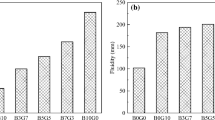Abstract
Up to now magnesium phosphate cements are mainly being utilized in wastewater treatment due to their adsorptive properties. Recently they also have been shown to have a high potential as degradable biocements for application as replacement materials for bone defects. In comparison to degradable calcium phosphate cements they have the advantage of setting at neutral pH, which is favorable in biological environment. In this study two parameters of the cement composition, namely powder-to-liquid ratio (PLR) and citrate content, were varied in order to optimize the injectability properties of the cement paste and the mechanical properties of the reaction product. These properties were determined by means of testing setting time and temperature, paste viscosity, and injectability as well as phase composition and compressive strength of the set cements. Best results were obtained, when the cements were prepared with a PLR of 2.5 and a binder liquid consisting of an aqueous solution of 3 mol/l diammonium hydrogen phosphate and 0.5 mol/l diammonium citrate.




Similar content being viewed by others
References
Bohner M. Physical and chemical aspects of calcium phosphates used in spinal surgery. Eur Spine J. 2001;10:114–21.
Pittet C, Lemaitre J. Mechanical characterization of brushite cements: a Mohr circles’ approach. J Biomed Mater Res. 2000;53(6):169–780.
Theiss F, Apelt D, Brand BA, Kutter A, Zlinszky K, Bohner M, Matter S, Frei C, von Auer JA. Biocompatibility and resorption of a brushite calcium phosphate cement. Biomaterials. 2005;26(21):4383–94.
Oberle A, Theiss F, Bohner M, Muller J, Kastner SB, Frei C, Zlinszky K, Wunderlin S, von Auer JA, von Rechenberg B. Investigation about the clinical use of brushite-and hydroxylapatite-cement in sheep. Schweiz Arch Tierh. 2005;147(11):482–90.
Kuemmerle JM, Oberle A, Oechslin C, Bohner M, Frei C, Boecken I, von Rechenberg B. Assessment of the suitability of a new brushite calcium phosphate cement for cranioplasty—an experimental study in sheep. J Cranio-Maxillofac Surg. 2005;33(1):37–44.
Bohner M. pH variations of a solution after injecting brushite cements. Key Eng Mater. 2000;192–195:813–6.
Coe FL, Evan A, Worcester E. Kidney stone disease. J Clinic Invest. 2005;115(10):2598–608.
Rahaman MS, Mavinic DS, Bhuiyan MIH, Koch FA. Exploring the determination of struvite solubility product from analytical results. Environ Tech. 2006;27(9):951–61.
Bhuiyan MI, Mavinic DS, Beckie RD. A solubility and thermodynamic study of struvite. Environ Technol. 2007;28(9):1015–26.
Driessens FCM, Boltong MG, Wenz R, Meyer J. Calcium phosphates as fillers in struvite cements. Key Eng Mater. 2005;284–286:161–4.
Hall DA, Stevens R, El Jazairi B. Effect of water content on the structure and mechanical properties of magnesia-phosphate cement mortar. J Am Ceram Soc. 1998;81(6):1550–6.
Sarkar AK. Hydration dehydration characteristics of struvite and dittmarite pertaining to magnesium ammonium phosphate cement systems. J Mater Sci. 1991;26(9):2514–8.
Vorndran E, Ewald A, Müller FA, Zorn K, Kufner A, Gbureck U. Formation and properties of magnesium–ammonium–phosphate hexahydrate biocements in the Ca–Mg–PO4 system. J Mater Sci Mater Med. 2011;22:429–36.
Banfill PFG. The rheology of fresh cement and concrete—a review. In: Grieve G, Owens G, editors. Proceedings on the 11th international cement chemistry congress, Durban, 2003, pp 13.
Gbureck U, Barralet JE, Grover LM, Spatz K, Thull R. Ionic modification of calcium phosphate cement viscosity. Part I: hypodermic injection and strength improvement of apatite cements. Biomaterials. 2004;25:2187–95.
Baroud G, Bohner M, Heini P, Steffen T. Injection biomechanics of bone cements used in vertebroplasty. Biomed Mater Eng. 2004;14:487–504.
Khairoun I, Boltong MG, Driessens FCM, Planell JA. Some factors controlling the injectability of calcium phosphate bone cements. J Mater Sci Mater Med. 1998;9:425–8.
Ishikawa K, Asoaka K. Estimation of ideal mechanical strength and critical porosity of calcium phosphate cement. J Biomed Mater Res. 1995;29:1537–43.
Leroux L, Hatim Z, Freche M, Lacout JL. Effects of various adjuvants (lactic acid, glycerol and chitosan) on the injectability of a calcium phosphate cement. Bone. 1999;25(2):31–4.
Ginebra MP, Rilliard A, Fernandez E, Elvira C, San Roman J, Planell JA. Mechanical and rheological improvement of a calcium phosphate cement by the addition of a polymeric drug. J Biomed Mater Res. 2001;57(1):113–8.
Mestres G, Ginebra MP. Novel magnesium phosphate cements with high early strength and antibacterial properties. Acta Biomater. 2011;7(4):1853–61.
Bohner M, Baroud G. Injectability of calcium phosphate pastes. Biomaterials. 2005;26(13):1553–63.
Burguera EF, Xu HHK, Sun L. Injectable calcium phosphate cement: effects of powder-to-liquid ratio and needle size. J Biomed Mater Res. 2008;84B:493–502.
Ewald A, Helmschrott K, Knebl G, Mehrban N, Grover LM, Gbureck U. Effect of cold-setting calcium- and magnesium phosphate matrices on protein expression in osteoblastic cells. J Biomed Mater Res. 2010;96B:326–32.
Großardt C, Ewald A, Grover LM, Barralet JE, Gbureck U. Passive and active in vitro resorption of calcium and magnesium phosphate cements by osteoclastic cells. Tissue Eng. 2010;16A(12):3687–95.
Li C, Mason J, Yakimicki D. Thermal characterization of PMMA-based bone cement curing. J Mater Sci Mater Med. 2004;15(1):85–9.
Author information
Authors and Affiliations
Corresponding author
Rights and permissions
About this article
Cite this article
Moseke, C., Saratsis, V. & Gbureck, U. Injectability and mechanical properties of magnesium phosphate cements. J Mater Sci: Mater Med 22, 2591–2598 (2011). https://doi.org/10.1007/s10856-011-4442-0
Received:
Accepted:
Published:
Issue Date:
DOI: https://doi.org/10.1007/s10856-011-4442-0



